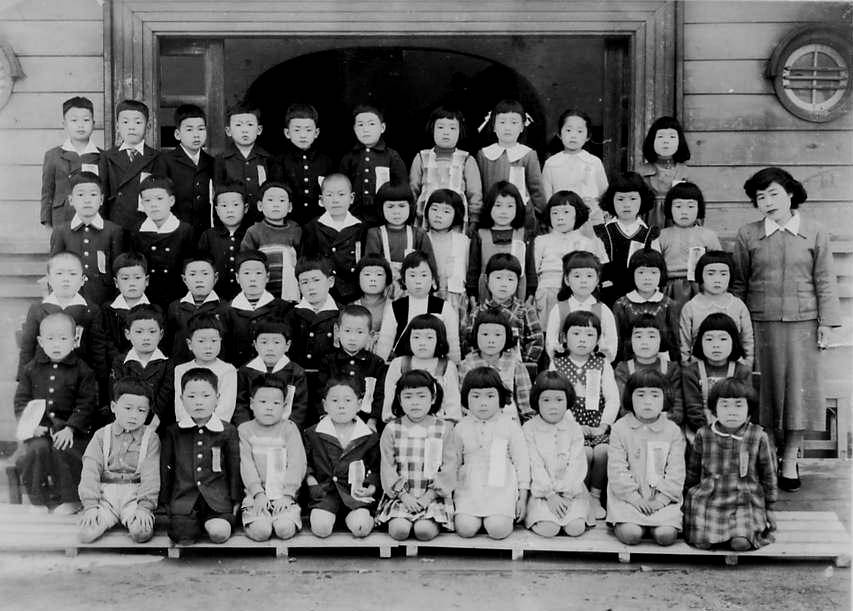
Unidentified City Primary School (1964)

Figure 1.--This class portrait was dated 1964, we would have guessed that the 1950s were more likely but are not at all sure. Internet dating is not always accurate. Many of the boys wear various styles of jackets. Our archive for the 60s is very limited.
|
|
This class portrait was dated 1964. That is all we know about it. We would have guessed that the 1950s were more likely but are not at all sure. Our archive for the period is still very limited, but we are gradually building it. . Internet dating is not always accurate. So although the source specified, 1964, we can not always take that as accurate. We can tell from the age of the children that this was a class, so this was not a small country school. These look to be some of the younger children at the school. The building in the background suggests to us that this was not a big city urban school. The fashionable dress of the teacher and girls suggests it was also not a rural school. We see a lot of public primary schools like this in the 1950s. The Japanese Army uniforms are gone. Some of the boys wear the Prussian cadet uniforms, but we see other jacket styles. Apparently it was not a strict requirement because not all of the boys wear the cadet uniforms or suit jackets. Most of the children wear short pants, but one boy wears long pants with his cadet jacket. The girls do not wear uniforms at all. We see all kinds of fashionable dresses. We are not sure if the children are wearing long stockings are tights. A reader writes, "The children here the front row could be wearing long stockings--beige or tan stockings, not white. I think that in the 1960s parents had the option of both long stockings and tights so that we could possibly see some diversity. But one boy in the second row (extreme left)is wearing long pants, so there is no uniformity." HBC is not sure precisely when tights first appeared in Japanese schools.
Chronology
This class portrait was dated 1964. That is all we know about it. We would have guessed that the 1950s were more likely but are not at all sure. Our archive for the period is still very limited, but we are gradually building it. . Internet dating is not always accurate. So although the source specified, 1964, we can not always take that as accurate.
The School
We can tell from the age of the children that this was a class, so this was not a small country school. These look to be some of the younger children at the school. The building in the background suggests to us that this was not a big city urban school. The fashionable dress of the teacher and girls suggests it was also not a rural school.
Schoolwear
We see a lot of public primary schools like this in the 1950s. The Japanese Army uniforms are gone. Some of the boys wear the Prussian cadet uniforms, but we see other jacket styles. We see quite a range of jacket styles, lthough the prominant buttons give a misleading impression thatmost of the boys are wearing the cadet uniforms. Apparently it was not a strict requirement because not all of the boys wear the cadet uniforms or suit jackets. Some of the boys are wearing Eton styled jackets, some no uniforms and others military style jackets. Not ll th boys wear jackrts. Also some seem to have ribbons or diplomas in their hands. This is probably a kindergarten graduation and the children are wearing the various uniforms (when required) of the schools they will be attending. Most of the children wear short pants, but it was not a requirement. One boy wears long pants with his cadet jacket. The girls do not wear uniforms at all. We see all kinds of fashionable dresses. We are not sure if the children are wearing long stockings are tights. A reader writes, "The children here the front row could be wearing long stockings--beige or tan stockings, not white. I think that in the 1960s parents had the option of both long stockings and tights so that we could possibly see some diversity. But one boy in the second row (extreme left)is wearing long pants, so there is no uniformity." HBC is not sure precisely when tights first appeared in Japanese schools.
HBC-SU

Related Chronolgy Pages in the Boys' Historical Web Site
Late 19th century]
[The 1900s]
[The 1910s]
[The 1920s]
[The 1930s]
[The 1940s]
[The 1950s]
[The 1960s]
[The 1970s]
[The 1980s]
Navigate the Boys' Historical Clothing School Uniform Pages
[Australia]
[England]
[France]
[Germany]
[Ireland]
[Italy]
[Japan]
[New Zealand]
[Scotland]
[United States]
Related Style Pages in the Boys' Historical Web Site
[Long pants suits]
[Short pants suits]
[Socks]
[Eton suits]
[Jacket and trousers]
[Blazer]
[School sandals]
Navigate the Boys' Historical Clothing Web Page
[Return to Main Japanese individual public school page]
[Return to Japanese 1960s primary schools]
[Return to Main Japanese school page]
[Return to Main school uniform page]
[Introduction]
[Activities]
[Biographies]
[Chronology]
[Cloth and textiles]
[Clothing styles]
[Countries]
[Topics]
[Bibliographies]
[Contributions]
[FAQs]
[Glossaries]
[Images]
[Images]
[Links]
[Registration]
[Tools]
[Boys' Clothing Home]
Created: 1:02 AM 9/5/2011
Last updated: 8:45 AM 9/6/2011




